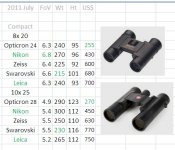vkalia, Kimmo Absetz - who sometimes posts here - tested the reverse porro-prism Opticron Taiga 8x25 against three 8x20 alpha roof-prism compacts for Alula in 2006. The test used to be available as a downloadable pdf but seems to have disappeared from the Alula website.
Kimmo found that the Taiga matched the roofs' sharpness, albeit with more flare, more edge distortion and a narrower field of view. However, in my opinion, you should also consider build quality. A cheaper, plastic-bodied compact cannot be repaired cost-effectively if damaged and should therefore be considered a throwaway item, while a well-engineered binocular from one of the top manufacturers is an investment that will last a lifetime. It's a case of "buy cheap, buy twice".
pompadour, Thank you for the chart showing that the Swarovski 8x20 is a little longer, but lighter, than the others. Choosing between these models is of course down to personal preference. When you handle them and look through them, some will appeal more than others and different models will appeal to different people. You should be guided by what you see, what you feel and how much money you want to spend.
Because the Swarovski 8x20 - my personal favourite - often gets mediocre reviews on this and other forums, I wanted to point out that its optics have improved significantly in recent years and that it is now back as a serious contender in the pocket compact market.





